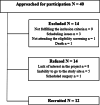A feasibility study on the use of cranial nerve non-invasive neuromodulation to improve affected arm function in people in the chronic stage of a stroke
- PMID: 40380081
- PMCID: PMC12082858
- DOI: 10.1186/s12883-025-04213-5
A feasibility study on the use of cranial nerve non-invasive neuromodulation to improve affected arm function in people in the chronic stage of a stroke
Abstract
Background: Chronic stroke survivors are often left with residual arm muscle weakness impeding arm function, daily life activities and quality of life. Exercise is one of the main post-stroke interventions to improve arm function, with cranial nerve non-invasive neuromodulation (CN-NINM) emerging as a potentially interesting complementary therapy to enhance its benefits. Only one study has evaluated the impact of CN-NINM combined with a lower-limb training program on improved balance in subacute stroke survivors. The aim of this study was to assess the feasibility and explore the effects on motor function of an arm strengthening program combined with CN-NINM in chronic stroke survivors (> 6 months).
Methods: Twelve (12) participants (69 ± 11 years) took part in this feasibility study. Recruitment and drop-out rates, number of people who elected not to participate, adherence and adverse events were collected to assess feasibility. The effects of CN-NINM + exercise on motor function were evaluated by changes in arm motor function, measured using the Fugl-Meyer Assessment (FMA), and functional performance, evaluated through the Wolf Motor Function Test (WMFT), following a 4-week arm strengthening program (60 min, 3 sessions/week) combined with CN-NINM (tongue stimulation, 20 min at a comfortable intensity). Descriptive and non-parametric statistics (Wilcoxon signed-ranks test) were used to describe feasibility data and explore CN-NINM effects.
Results: Feasibility was confirmed with a recruitment rate of 1.3 person/month, no dropout, a 100% adherence rate, and no serious adverse events. A significant gain in FMA (p = 0.003) with a trend for WMFT (P = 0.11) were noted post-intervention.
Conclusion: This study suggests that CN-NINM combined with an arm strengthening program is feasible and may improve arm function in chronic stroke survivors. Further research is needed to validate the results.
Trial registration: This clinical trial was registered on ClinicalTrials.gov (NCT05370274) on April 27, 2022.
Keywords: Cranial nerve non-invasive neuromodulation; Motor function; Strength training program; Stroke; Upper limb.
© 2025. The Author(s).
Conflict of interest statement
Declarations. Ethics approval and consent to participate: The study was approved by the CIUSSS de l’Estrie-CHUS Ethics Committee. All participants gave signed, written informed consent in accordance with the Declaration of Helsinki and the Tri-Council Policy Statement: Ethical Conduct for Research Involving Humans (TCPS 2) before participating in the experiment. Consent for publication: Not applicable. Competing interests: The authors declare no competing interests.
Similar articles
-
Reaching exercise for chronic paretic upper extremity after stroke using a novel rehabilitation robot with arm-weight support and concomitant electrical stimulation and vibration: before-and-after feasibility trial.Biomed Eng Online. 2020 May 6;19(1):28. doi: 10.1186/s12938-020-00774-3. Biomed Eng Online. 2020. PMID: 32375788 Free PMC article.
-
Robot-assisted training compared with an enhanced upper limb therapy programme and with usual care for upper limb functional limitation after stroke: the RATULS three-group RCT.Health Technol Assess. 2020 Oct;24(54):1-232. doi: 10.3310/hta24540. Health Technol Assess. 2020. PMID: 33140719 Free PMC article. Clinical Trial.
-
Aerobic exercise prior to task-specific training to improve poststroke motor function: A case series.Physiother Res Int. 2018 Apr;23(2):e1707. doi: 10.1002/pri.1707. Epub 2018 Feb 13. Physiother Res Int. 2018. PMID: 29436126 Review.
-
Efficacy, safety, and tolerability of bilateral transcranial direct current stimulation combined to a resistance training program in chronic stroke survivors: A double-blind, randomized, placebo-controlled pilot study.Restor Neurol Neurosci. 2019;37(4):333-346. doi: 10.3233/RNN-190908. Restor Neurol Neurosci. 2019. PMID: 31227673 Clinical Trial.
-
Effects of brain-computer interface based training on post-stroke upper-limb rehabilitation: a meta-analysis.J Neuroeng Rehabil. 2025 Mar 3;22(1):44. doi: 10.1186/s12984-025-01588-x. J Neuroeng Rehabil. 2025. PMID: 40033447 Free PMC article. Review.
References
-
- Feigin VL, Brainin M, Norrving B, Martins S, Sacco RL, Hacke W, et al. World stroke organization (WSO): global stroke fact sheet 2022. Int J Stroke. 2022;17(1):18–29. 10.1177/17474930211065917. - PubMed
-
- Bourbonnais D, Bilodeau S, Lepage Y, Beaudoin N, Gravel D, Forget R. Effect of Force-Feedback treatments in patients with chronic motor deficits after a stroke. Am J Phys Med Rehabil. 2002;81(12):890–7. 10.1097/00002060-200212000-00002. - PubMed
-
- Cauraugh JH, Kim SB. Chronic stroke motor recovery: duration of active neuromuscular stimulation. J Neurol Sci. 2003;215(1):13–9. 10.1016/S0022-510X(03)00169-2. - PubMed
-
- Patten C, Lexell J, Brown HE. Weakness and strength training in persons with poststroke hemiplegia: rationale, method, and efficacy. J Rehabilitation Res Dev. 2004;41(3A):293–312. 10.1682/JRRD.2004.03.0293. - PubMed
Publication types
MeSH terms
Associated data
LinkOut - more resources
Full Text Sources
Medical
Miscellaneous


